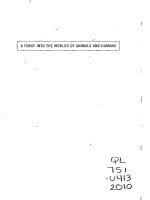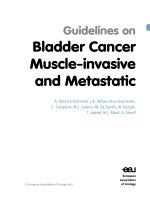HYPOGLYCEMIA – CAUSES AND OCCURRENCES doc
Bạn đang xem bản rút gọn của tài liệu. Xem và tải ngay bản đầy đủ của tài liệu tại đây (8.89 MB, 250 trang )
HYPOGLYCEMIA – CAUSES
AND OCCURRENCES
Edited by Everlon Cid Rigobelo
Hypoglycemia – Causes and Occurrences
Edited by Everlon Cid Rigobelo
Published by InTech
Janeza Trdine 9, 51000 Rijeka, Croatia
Copyright © 2011 InTech
All chapters are Open Access articles distributed under the Creative Commons
Non Commercial Share Alike Attribution 3.0 license, which permits to copy,
distribute, transmit, and adapt the work in any medium, so long as the original
work is properly cited. After this work has been published by InTech, authors
have the right to republish it, in whole or part, in any publication of which they
are the author, and to make other personal use of the work. Any republication,
referencing or personal use of the work must explicitly identify the original source.
Statements and opinions expressed in the chapters are these of the individual contributors
and not necessarily those of the editors or publisher. No responsibility is accepted
for the accuracy of information contained in the published articles. The publisher
assumes no responsibility for any damage or injury to persons or property arising out
of the use of any materials, instructions, methods or ideas contained in the book.
Publishing Process Manager Alenka Urbancic
Technical Editor Teodora Smiljanic
Cover Designer Jan Hyrat
Image Copyright Sean Gladwell, 2011. Used under license from Shutterstock.com
First published September, 2011
Printed in Croatia
A free online edition of this book is available at www.intechopen.com
Additional hard copies can be obtained from
Hypoglycemia – Causes and Occurrences, Edited by Everlon Cid Rigobelo
p. cm.
ISBN 978-953-307-657-7
free online editions of InTech
Books and Journals can be found at
www.intechopen.com
Contents
Preface IX
Part 1 Section A 1
Chapter 1 A New Therapy of Type 2 Diabetes:
DPP-4 Inhibitors 3
Tatjana Ábel
Chapter 2 Relationship Between Age and
Diabetic Treatment Type on the Frequency
of Hyperglycemic Episodes Monitored by
Continuous Glucose Monitoring 15
Boby G. Thekadeth, P. Zachariah, Zeenat Parveen,
Pavan Patel, Matthew Schoeck, Andrew Mazulis,
Lawrence Perlmuter and Sant P. Singh
Chapter 3 Development of Mulberry Leaf Extract for
Suppressing Postprandial Blood Glucose Elevation 25
Toshiyuki Kimura
Chapter 4 Pathogenetic Mechanisms of Exercise-Associated
Hypoglycemia: Permanent and Reversible
Counterregulatory Failure 37
Pietro Galassetti
Part 2 Section B 53
Chapter 5 An Update on Neonatal Hypoglycemia 55
Praveen Kumar and Shiv Sajan Saini
Chapter 6 Neonatal Hypoglycemia - Current Concepts 85
Blanca Álvarez Fernández and Irene Cuadrado Pérez
Chapter 7 Glucose Infusions into Peripheral
Veins in Neonates with Hypoglycemia 103
Outi Tammela and Tarja Vanhatalo
VI Contents
Part 3 Section C 111
Chapter 8 Drug-Induced Hypoglycemia 113
Kristen Helms and Kristi Kelley
Chapter 9 Drugs and Hypoglycemia 131
Marek Pytliak, Viola Vargová and Viola Mechírová
Part 4 Section D 149
Chapter 10 Insulinoma – Diagnosis and Treatment 151
Jan Škrha, Jaroslava Dušková, Jan Šváb,
Jiřina Hilgertová, Josef Hořejš and Radan Keil
Chapter 11 Pancreatogenous Hypoglycemic Syndrome - Insulinoma
or Non-Insulinoma Origin (NIPHS) 173
Chen-Hsen Lee, Justin Ging-Shing Won and Hsiao-Shan Tseng
Chapter 12 Pancreatic Beta Cell Tumors 187
M. Isabel del Olmo, J. Francisco Merino-Torres,
J. Luis Ponce and Angel Moya
Part 5 Section E 219
Chapter 13 Hypoglycemia Caused by Septicemia in Pigs 221
Everlon Cid Rigobelo and Fernando Antonio de Ávila
Preface
Hypoglycemia is a disorder where the glucose serum concentration is usually low. The
organism usually keeps the serum glucose concentration in a range of 70 to 110 mL/dL
of blood. In hypoglycemia the glucose concentration remains normally lower than 50
mL/dL of blood.
Glucose is an essential metabolic substrate of all mammalian cells being the major
carbohydrate presented to the cell for energy production and also many other anabolic
requirements.
This book comprehensively reviews and compiles information on hypoglycemia in 15
chapters which cover occurrence, damages, treatments and preventions, and relevant
discussions about the occurrence of hypoglycemia in neonates, drug-induced and
caused by infections in animals.
This book is written by an international group of authors from America, Europe, Asia
and Africa. The editor has tried to arrange the book chapters in an issue order to make
it easier for the readers to find what they need. However, the reader can still find
different approaches on the same issue in the same Section.
Section A, which includes chapters 1-4, mainly presents therapy. It includes some
treatment methods and their applications.
Section B, which includes chapters 5-7, mainly deals with the occurrence of
hypoglycemia in neonates. It shows different approaches to the same issue.
Section C, which includes chapters 8-9, covers hypoglycemia associated with drugs.
Section D, which includes chapters 10-12, covers hypoglycemia caused by some kinds
of cancer.
Section E, which includes chapter 13, deals with hypoglycemia caused by septicemia
in animals. It shows that the hypoglycemia may be a parameter that could be analyzed
for detection of Leptospire infection in pigs.
The scientists selected to publish in this book were invited because of their recognized
expertise and important contributions in their respective fields of research. Without
X Preface
these scientists and their dedication and enthusiasm, the publication of this book
would not have been possible. I recognize and am very grateful for their efforts and
the attempt to decrease the suffering of many people afflicted with this disorder.
Hopefully, this book will be of help to many scientists, doctors, pharmacists, chemicals
and other experts in a variety of disciplines, both academic and industrial. In addition
to supporting research and development, this book should also be suitable for
teaching.
Finally, I would like to thank my daughter Maria Eduarda and my wife Fernanda for
their patience. I extend my apologies for many hours spent on the preparation of my
chapter and the editing of this book, which kept me away from them.
Prof. Dr. Everlon Cid Rigobelo
Laboratory of Microbiology & Hygiene,
Campus Experimental de Dracena
Animal Science Faculty
Dracena
Brazil
Part 1
Section A
1
A New Therapy of Type 2
Diabetes: DPP-4 Inhibitors
Tatjana Ábel
National Health Center
Hungary
1. Introduction
Type 2 diabetes is a progressive disease which is significantly spreading all over the world.
It is characterized by developing insulin resistance, impairment of the pancreatic beta cells
and an impaired suppression of glucagon production of the pancreatic alpha cells (Figure 1)
(DeFronzo 2009). When choosing a therapy for it, several aspects should be taken into
consideration, e.g. is a patient obese or has he/she a normal body weight; is he/she elderly;
a
Szemléltető ábrázolás
.
Insulin resistance
Postprandial
glucose level
Fasting glucose level
β-cell function
Progression
Impaired glucose tolerance
Diagnosis
Type 2 Diabetes
4–7 years
Development of macrovascular complication
Development of microvascular complication
Insulin level
Fig. 1. Type 2 diabetes features
how long has his/her diabetes been known; were there any side effects caused by his/her
previous antidiabetic medication, and are there any complications present (e.g.
nephropathy). A good glycemic control reduces the rates of diabetes-associated
microvascular and possibly macrovascular complications. Reduction of the associated risk
Hypoglycemia – Causes and Occurrences
4
factors, including those related to excessive weight, high blood pressure and dyslipidemia
are also necessary to meaningfully decrease cardiovascular risk. Agents that can improve
glycemia with weight neutrality could offer an additional benefit to overweight patients
with type 2 diabetes. Many new drugs are currently in development for the treatment of
diabetes, including products with a new mechanism of action such as dipeptidyl peptidase-
4 (DPP-4) inhibitors.
2. Mechanisms of DPP-4 inhibitor action
Up to now the treatment of type 2 diabetes has been limited primarily to elevation of insulin
production, increase of insulin sensitivity, reduction of glucose absorption and replacement
of insulin. In the recent years, however, DPP-4 inhibitors (gliptins) emerged. These belong to
a novel group of medicines which exert their action by increasing incretin levels (Drucker,
Sherman et al. 2010). Incretins include glucagon-like peptide 1 (GLP-1) and glucose-
dependent insulinotropic polypeptide (GIP) which are produced in the intestine and
contribute to the physiological regulation of glucose homeostasis (Thornberry and Gallwitz
2009) (Figure 2). Active endogenous GLP-1 and GIP concentrations increase two- to
threefold following a meal. Active GLP-1 and GIP increase the production and release of
insulin by pancreatic beta cells. Approximately 60% of the postprandial insulin release is
promoted by these two hormones. In addition, GLP-1 also reduces the secretion of glucagon
by pancreatic alpha cells, resulting in a decreased hepatic glucose production. These effects
are glucose-dependent; GLP-1 stimulates insulin secretion and reduces glucagon production
only at a higher blood glucose level. However, the effects of GLP-1 and GIP last only for a
few minutes as they are inactivated due to DPP-4 (Thornberry and Gallwitz 2009).
ß
ß
-
-
cell
cell
active
incretins
(GLP-1 and
GIP) release
Pancreas
Insulin release
glucagon
secretion
and release
DPP- 4
inhibitor
Inactive incretins
(GLP-1 and GIP)
α
α
-
-
cell
cell
Food intake
DPP-4
GI tract
Liver
glucose
production
Glucose uptake
in a peripheral
tissue
glucose
release from
the liver
B
L
O
O
D
G
L
U
C
O
S
E
GLP-1 and GIP
GLP-1
DPP-4 = dipeptidyl peptidase-4; GI = gastrointestinal; GIP = glucose-dependent insulinotropic
polypeptide; GLP-1 = glucagon-like peptide-1;
Fig. 2. Mechanisms of DPP-4 inhibitor action.
A New Therapy of Type 2 Diabetes: DPP-4 Inhibitors
5
The promising therapeutic potential of GLP-1 as a pharmacologycal tool for treating type 2
diabetes has been discovered in the 1990s. By inhibiting DPP-4, the gliptins increase insulin
production and release as well as reduce glucagon levels in a glucose-dependent way,
resulting in a decrease of fasting and postprandial glycemia, as well as HbA1c levels
(Nauck, Vilsboll et al. 2009). Further, it has the ability to restore the blunted first phase
insulin secretion in type 2 diabetes. Also in this respect, their mechanism of action differs
from that of the sulfonylureas which stimulate insulin secretion also at low levels of blood
glucose and may lead to hypoglycemia.
Fix combinations of sitagliptin and then vildagliptin with metformin have also been
launched; these affect pathogenic factors of type 2 diabetes at more target points: they
reduce the extent of insulin resistance, regulate insulin secretion in a glucose-dependent
way, reduce glucagon secretion and also decrease hepatic glucose production (Nauck,
Vilsboll et al. 2009). Their effects are additive, levels of active GLP-1 are increased not only
by DPP-4 inhibitors but by metformin as well (Cho and Kieffer 2011).
3. Clinical and experimental evidence with the DPP-4 inhibitors
The oral antidiabetic drugs (OADs) used before the emergence of DPP-4 inhibitors may
cause significant side effects including e.g. gastrointestinal symptoms, weight gain, cardiac
heart failure, myocardial infarction, bone fractures and hypoglycemia and they do not
reverse the progressive decline in beta cell function. Among others this led to the
development of newer OADs, the DPP-4 inhibitors.
As a first step, according to the consensus statement of the European Diabetes Association for
the Study of Diabetes (EASD) and the American Diabetes Association (ADA), in patients with
no metabolic upset, lifestyle changes and metformin are recommended (Nathan, Buse et al.
2009). If no sufficient metabolic control can be attained by this way (HbA1c > 7%), or the
patient should not receive metformin (it is not tolerated or it is contraindicated), addition of an
oral antidiabetic of second choice is recommended. Although DPP-4 inhibitors are mentioned
as second-line drugs among the less validated therapies, this seems to have to be changed due
to the increasing amount of study results published in relation to them.
The use of sitagliptin, the first oral DPP-4 inhibitor was approved by the Food and Drug
Administration (FDA) and the European Medicines Agency (EMA) in 2006 and in 2007
respectively (Gerich 2010). Sitagliptin can be given in monotherapy or in combination with
metformin, sulfonylurea, thiazolidinediones, or as a triple combination with metformin and
sulfonylurea or metformin and thiazolidinediones both in the USA and Europe. In the recent
years a fix combination of sitagliptin/metformin has also been available. Concomitant
administration of sitagliptin with insulin has been approved by FDA and EMA in 2010.
Saxagliptin can be used in combination with other OADs (metformin, sulfonylurea,
thiazolidinediones) both in the USA and in Europe in 2007 (Gerich 2010).
Marketing of vildagliptin was not approved by the FDA due to dermal lesions and renal
impairment observed in animal studies. In Europe, based on the approval of EMA in 2008,
vildagliptin can be given with metformin, sulfonylurea or thiazolidinediones. A fix
combination of vildagliptin/metformin has also been marketed.
3.1 Clinical efficacy
As far the results have shown no difference between DPP-4 inhibitors in the reduction of
HbA1c values. Both in monotherapy and in combination (with metformin, sulfonylurea,
Hypoglycemia – Causes and Occurrences
6
thiazolidinediones, or insulin) they effectively reduce HbA1c levels (by 0.6% to 1.1%)
(Ahrén 2011). This effect has proven to be dependent of diabetes duration and baseline
HbA1c values as well. Greater reductions in HbA1c are seen in subjects with higher baseline
levels and they are more effective in patients with shorter diabetes duration (< 3 years). A
survey summarized the results of 18 publications and 3 presentations where elderly (≥ 65
years) patients with type 2 diabetes received DPP-4 inhibitor (sitagliptin, saxagliptin,
vildagliptin, or alogliptin) treatment in monotherapy or in combination (metformin,
glimepiride, glibenclamide, thiazolidinediones or insulin) (Schwartz 2010). No significant
difference was found in the HbA1c level reducing effect of DPP-4 therapy in elderly and in
younger patients.
Although the DPP-4 inhibitors differ from each other in several aspects, it is not known yet
whether this means any substantial difference in their e.g. long-term efficacy (Table 1).
Inhibitor Metabolism Elimination route Dosing DPP-4 selectivity DPP-4 inhibition*
Sitagliptin not appreciably metabolized renal (~ 80% unchanged
as parent) 100mg qd high max ~ 97%; > 80% 24 h postdose
Vildagliptin hydrolyzed to inactive metabolite renal (22% as parent,
(P
450
enzyme independent) 55% as primary metabolite) 50mg bid moderate max ~ 95%; > 80% 12 h postdose
Saxagliptin hepatically metabolized to renal (12-29% as parent,
active metabolite (via P
450
3A4/5) 21-52% as metabolite) 5mg qd moderate max ~ 80%; ~ 70% 24 h postdose
Table 1. Characteristics of DPP-4 inhibitors.
3.2 Hypoglycemia
Intensive glucose control increases the risk of developing hypoglycemia. In the Diabetes
Control and Complications Trial (DCCT) the rate of severe hypoglycemia was 65% and 35% in
the arms of intensive and conventional insulin therapy respectively (Keen 1994; The Diabetes
Control and Complications Trial Research Group 1997). In the UK Diabetes Prospective Study
the episodes of major hypoglycemia occurred in 0.7%, 1.4% and 1.8% in the groups receiving
conventional, glibenclamide and insulin treatment respectively (Gore, McGuire 2009). Some
epidemiological studies and minor prospective studies found that hypoglycemia increased
cardiovascular risk (Desouza, Bolli et al. 2010). Its occurrence and a severe, even fatal outcome
are not rare in patients with type 2 diabetes, primarily during the administration of insulin
therapy and use of medicines which stimulate insulin secretion (sulfonylurea). Far from
enough importance seems to have been attributed to hypoglycemia in the practice, although it
increases the risk of accidents in certain situations, it impairs cognitive function, it may cause
hemorrhage at the fundus and in the vitreous body, but it may also play a role in the
development of tachycardia, hypertension and arrhythmia (Desouza, Bolli et al. 2010).
Therefore it represents a not negligible risk for morbidity and mortality.
Hypoglycemia is a potential side effect of OAD, primarily sulfonylurea, therapy. As
compared to metformin, sulfonylurea therapy represents an approximately threefold risk. In
A New Therapy of Type 2 Diabetes: DPP-4 Inhibitors
7
contrast, there has been a very low occurrence of hypoglycemia, nearly identical with that of
placebo, during DPP-4 inhibitor monotherapy or its combination with metformin of
thiazolidinedione (Blonde 2009). No differences were found in the risk of developing
hypoglycemia between each DPP-4 inhibitor treatments (Tahrani, Piya et al. 2010) (Table 2).
DPP - 4 inhibitors Study Any hypoglycemia
(number)
investigational drug / comparator
Sitagliptin
Scott, R., Loeys, T. et al. (2008) 1 / 1
Scott, R., Wu, M. et al. (2007) 12 / 21
Goldstein, B. J., Feinglos, M. N. et al. (2007) 1 / 1
Charbonnel, B., Karasik, A. et al. (2006) 6 / 5
Vildagliptin
Schweizer, A., Couturier, A. et al. (2007) 2 / 1
Bolli, G., Dotta, F. et al. (2008) 1 / 0
Bosi, E., Camisasca, R. P. et al. (2007) 1 / 1
Rosenstock, J., Baron, M. A. et al. (2007) 1 / 0
Saxagliptin
Rosenstock, J., Sankoh, S. et al. (2008) 0 / 0
Table 2. Occurrence of hypoglycemia during DPP-4 therapy.
While the DPP-4 inhibitors and the GLP-1 increase insulin production in a glucose-dependent
way, in contrast with them the sulfonylureas exert their effect via the ATP-dependent
potassium channel, even at low levels of blood glucose, and therefore they make patients
susceptible to hypoglycemia. Thus the incidence of hypoglycemia increases when DPP-4
inhibitors are combined with sulfonylurea. This has also been demonstrated in a metaanalysis
of studies with a great number of subjects (n=10246), where sitagliptin monotherapy or its
combination (with metformin, pioglitazone, sulfonylurea, sulfonylurea + metformin or
metformin + rosiglitazone) was compared with placebo or other OAD (metformin,
pioglitazone, sulfonylurea, sulfonylurea + metformin or metformin + rosiglitazone) treatment
in patients with type 2 diabetes (Williams-Herman, Engel et al. 2010). A lower incidence of
hypoglycemia (5.2%) was found in the group of sitagliptin therapy as compared to the control
group (12.1%) that could be attributed primarily to sulfonylurea therapy.
3.3 Body weight
There is no increase of body weight during treatment with DPP-4 inhibitors, and even a
reduction of it is possible during a combined therapy with metformin (Monami, Iacomelli et
al. 2010).
Hypoglycemia – Causes and Occurrences
8
The safety and tolerability of sitagliptin was investigated in patients with type 2 diabetes,
who were on a stable dose of metformin for at least 8 weeks and were randomised in
double–blind manner to receive either sitagliptin 100mg q.d. (n= 588) or glipizide
5mg/day (up-titrated, to a maximum dose of 20mg/day, based upon prespecified
glycemic criteria) (n= 584) (Seck, Nauck et al. 2010). The analysis showed that the addition
of sitagliptin to ongoing metformin monotherapy was associated with weight loss (-1.6
kg) compared with weight gain (+ 0.7 kg) with glipizide. In addition patients treated with
sitagliptin compared with those treated with glipizide had a lower incidence of
hypoglycemia (5% vs 34%).
The body weight neutral effect of DPP-4 inhibitors may prevail through several mechanisms
which include the following (Foley and Jordan 2010):
After a meal that is rich in fat, DPP-4 inhibitor treatment reduces the level of
chylomicron apoB-48 and so it hinders intestinal triglyceride absorption.
Postprandial catecholamine (norepinephrine) levels increase upon the administration of
DPP-4 inhibitors, resulting in an increased lipolysis in the adipose tissue and fatty acid
oxidation in the musculature.
3.4 Cardiovascular effects
Although it summarized the results of studies with non-cardiovascular endpoints, a
metaanalysis investigating the safety of sitagliptin (100mg/day) showed no substantial
differences as compared to the control group in relation to coronary artery disease (0.2 vs.
0.4 event per 100 patient-years), myocardial ischemia (0.0 vs. 0.2 event per 100 patient-years)
and acute myocardial infarction (0.1 vs. 0.2 event per 100 patient-years) respectively
(Williams-Herman, Engel et al. 2010).
A post hoc metaanalysis of saxagliptin’s effect on major cardiovascular events (CV death,
non-fatal MI, non-fatal stroke) showed no increase of CV risk in the treated patients (Wolf,
Friedrich et al. 2009).
Recently, a large outcome trial with sitagliptin (A randomized placebo controlled clinical
Trial to Evaluate Cardiovascular Outcomes after treatment with Sitagliptin in patients with
type 2 diabetes mellitus and inadequate glycaemic control on mono or dual combination
oral antihyperglycaemic therapy, TECOS) and with saxagliptin (Saxagliptin Assessment of
Vascular Outcomes Recorded in patients with diabetes mellitus, SAVOR-TIMI 53) has been
started.
GLP-1 receptors can be found in cardiac muscle cells and vascular endothelial cells as well
(Nauck and Smith 2009; Nikolaidis, Mankad et al. 2004). The beneficial effect of GLP-1 has
been demonstrated also in coronary ischemia and left ventricular failure both in animal
experiments and in human studies (Nikolaidis, Mankad et al. 2004; Bose, Mocanu et al. 2005;
Nikolaidis, Elahi et al. 2004). In rats, myocardial necrosis developed in a smaller area when
they received GLP-1 infusion (Bose, Mocanu et al. 2005). Following intravenous infusion of
GLP-1, less wall motion disorder and better left ventricular function developed in patients
with and without type 2 diabetes who had undergone angioplasty after acute myocardial
infarction (Nikolaidis, Mankad et al. 2004).
Based on these, a beneficial effect of DPP-4 inhibitors on cardiovascular disease may be
presumed, however further long-term clinical studies with a high number of patients are
required for an exact elucidation.
A New Therapy of Type 2 Diabetes: DPP-4 Inhibitors
9
3.5 Other side effects and potential for drug-drug interactions
Based on the results so far, DPP-4 inhibitors seem to have no group-specific side effects
(Nauck and Smith 2009; Hollander and Kushner 2010). An occurrence of slightly increased
upper respiratory symptoms was not confirmed by a metaanalysis investigating the safety
of sitagliptin therapy on a high number of subjects (29 placebo-controlled and 11 active
comparison studies) (Williams-Herman, Round et al. 2008). Also a similar result was
obtained in a study investigating the safety of vildagliptin (Ligueros-Saylan, Schweizer et al.
2010).
DPP-4 inhibitors are eliminated mostly through the kidneys, so that the question has
emerged whether they can be used in patients with impaired renal function (Table 1). The
results so far show that sitagliptin was tolerated well also in patients with mild, moderate
and severe renal failure (including those on dialysis) (Bergman, Cote et al. 2007). Currently
DPP-4 inhibitors are approved in patients with mild renal impairment (creatinine clearance
[C
Cr
] ≥ 50 mL/min) both in Europe and in the USA. However, in patients with moderately
(C
Cr
≥30 to < 50 mL/min) and severely (C
Cr
< 30 mL/min) impaired renal function / end
stage renal disease (ESRD) in Europe it is not approved, while in the USA sitagliptin and
saxagliptin can be given in a reduced dose (Deacon 2011).
In patients with mild and moderate liver disease, of the DPP-4 inhibitors solely sitagliptin
has been approved with no restrictions. Monitoring of transaminase levels is required before
and during saxagliptin therapy (Deacon 2011). If transaminase levels exceed three times the
upper limit of normal, the therapy should be discontinued. At present, vildagliptin should
not be given to patients with mild to moderate hepatic impairment. Neither DPP-4 inhibitor
is approved in patients with severely impaired hepatic function.
Results show that DPP-4 inhibitors cause no more interactions with other OADs (metformin,
pioglitazone, glyburide) or simvastatin. Only saxagliptin is metabolized via the CYP3A4/5
system; therefore a reduction of saxagliptin dose (2.5mg qd) is recommended when it is
administered concomitantly with a strong CYP3A4/5 inhibitor (e.g. ketoconazole) (Table 1).
3.6 ß-cell funcion
Typically, islet function has already declined by approximately 50% by the time patients
are diagnosed with type 2 diabetes mellitus (Wajchenberg 2007). Reduced pancreatic beta
cell mass, largely because of accelerated apoptosis, seems to account for, at least in part,
the impaired islet cell function (Butler, Janson et al. 2003). In vitro, neither sulfonylureas,
nor metformin protect beta cell from apoptosis (Maedler, Carr et al. 2005; Kefas, Cai et al.
2004) .
Studies in diabetic animals showed beneficial effects of GLP-1 on pancreatic beta cells
(Farilla, Hui et al. 2002; Mu, Petrov et al. 2009; Gallwitz and Häring 2010) (Figure 3). GLP-1
stimulates beta cell proliferation and differentiation while it hinders beta cell apoptosis both
in vitro and in animal studies. DPP-4 inhibitors increased the number of insulin-positive
beta-cells in islets and the beta to alpha cell ratio in different diabetic animals was
normalized.
The effects of sitagliptin vs. sulfonylurea therapy were compared in mice with type 2
diabetes (Mu, Petrov et al. 2009). Sitagliptin treatment was found to have repaired the
amount of beta and alpha cells and also alpha/beta cell rate to a significantly greater degree
as compared to glipizide therapy. The effect of sitagliptin therapy (50mg/day) on beta cell
function in patients with type 2 diabetes (n=28) taking metformin was analyzed in a double-
Hypoglycemia – Causes and Occurrences
10
blind randomized placebo-controlled study (Brazg, Xu et al. 2007). Beta cell function was
determined with the ‘C-peptide minimal model’ by measuring blood glucose and C-peptide
levels for 5 hours after a standardized breakfast. Sitagliptin therapy was found to have
significantly improved beta cell function in comparison to the placebo group. In addition
sitagliptin and vildagliptin significantly improved HOMA-B value and it also reduced the
proinsulin/insulin rate.
•proliferation
• hypertrophy
•neogenesis
•apoptosis
GLP-1
Beta cell regeneration and increase beta cell mass
Beta cell
Fig. 3. Effects of GLP-1 on beta cell.
Thus, DPP-4 therapy can delay or prevent the progression of type 2 diabetes, but further
studies are required in order to obtain a more exact knowledge relating to its effect on beta
cells, as well as its mechanism of action.
4. Conclusion
Large intervention studies demonstrated that antihyperglycemic therapy with treatment
goals aiming at normoglycemia can reduce the risk or the progression of microvascular as
well as macrovascular risk.
Sulfonylureas, glinides and insulin therapy are associated with an increased risk for
hypoglycemia and are also associated with weight gain. The novel incretin based therapies
with DPP-4 inhibitors, both in monotherapy and in combination therapy, can effectively
reduce fasting and postprandial blood glucose levels and also HbA1c value. When
administered concomitantly with metformin, their GLP-1-increasing effects are additive.
A New Therapy of Type 2 Diabetes: DPP-4 Inhibitors
11
Based on studies and clinical experience so far, they can be tolerated very well, and they
cause no increase of body weight, hypoglycemia and gastrointestinal side effects and the
potential, based on animal and in vitro studies, for preservation or enhancement of beta cell
function. Their administration is particularly beneficial in overweight patients who
represent the majority of patients with type 2 diabetes, as well as in elderly patients and in
diabetics who are susceptible to hypoglycemia. At present, there seems to be little to
distinguish between the different inhibitors in terms of their efficacy as antidiabetic agents
and their safety. Long-term accumulated clinical experience will reveal whether compound-
related characteristics lead to any clinically relevant differences.
In the future further gliptins (alogliptin, linagliptin, denagliptin) may be marketed, with
which Phase III studies are in progress or the results have already been published.
5. References
DeFronzo, R.A. (2009) From the triumvirate to the ominosus octet: a new paradigm for the
treatment of type 2 diabetes mellitus. Diabetes 58 (4): 773-795.
Drucker, D.J., Sherman, S.I. et al. (2010) Incretin-based therapies for the treatment of type 2
diabetes: evaluation of the risks and benefits. Diabetes Care 33 (2): 428-33.
Thornberry, N.A., Gallwitz, B. (2009) Mechanism of action of inhibitors of dipeptidyl-
peptidase-4 (DPP-4). Best Practice & Research Clinical Endocrinology &
Metabolism 23 (4): 479-86.
Nauck, M.A., Vilsboll, T. et al. (2009) Incretin-based therapies. Diabetes Care 32 (11): S223-
31.
Cho, Y. M., Kieffer, T. J. (2011) New aspects of an old drug: metformin as a glucagon-like
peptide 1 (GLP-1) enhancer and sensitiser. Diabetologia 54 (2): 219-22.
Nathan, D. M., Buse, J. B. et al. (2009) Medical management of hyperglycemia in type 2
diabetes: A consensus algorithm for the initiation and adjustment of therapy.
Diabetes Care 32 (1): 193-203
Gerich, J. (2010) DPP-4 inhibitors: What may be the clinical differentiators? Diabetes
Research and Clinical Practice 90 (2):131-140.
Ahrén, B. (2011) Are sulfonylureas less desirable than DPP-4 inhibitors as add-on to
metformin in the treatment of type 2 diabetes? Curr Diab Rep 11(2): 83-90.
Schwartz, S. L. (2010) Treatment of elderly patients with type 2 diabetes mellitus: A
systematic review of the benefits and risks of diapeptidyl peptidase-4 inhibitors.
Tha American Journal of Geriatric Pharmacotherapy. 8 (5): 405-418.
Keen, H. (1994) The Diabetes Control and Complications Trial (DCCT). Health Trends 26:
41-43.
The Diabetes Control and Complications Trial Research Group. (1997) Hypoglycemia in the
Diabetes Control and Complications Trial. Diabetes 46: 271-186.
Gore, M. O., McGuire, D. K. (2009) The 10-year post-trial follow-up of the United Kingdom
Prospective Diabetss Study (UKPDS): cardiovascular observations in context. Diab
Vasc Dis Res 6: 53-55.
Desouza, C. V., Bolli, G. B. et al. (2010) Hypoglycemia, diabetes, and cardiovascular events.
Diabetes Care 33(6): 1389-1394.
Hypoglycemia – Causes and Occurrences
12
Blonde, L. (2009) Current antihyperglycemic treatment strategies for patients with type 2
diabetes mellitus. Cleveland Clinic Journal of Medicine 76, S4-11.
Tahrani, A. A., Piya, M. K. et al. (2010) Glycaemic control in type 2 diabetes: targets and new
therapies. Pharmacology and therapeutics 125(2): 328-361.
Scott, R., Loeys T. et al. (2008) Efficacy and safety of sitagliptin when added to ongoing
metformin therapy in patients with type 2 diabetes. Diabetes Obes Metab 10: 959-
69.
Scott, R. Wu, M. et al. (2007) Efficacy and tolerability of the dipeptidyl peptidaese-4 inhibitor
sitagliptin as monotherapy over 12 weeks in patients with type 2 diabetes. Int J
Clin Pract 61: 171-80.
Goldstein, B. J., Feinglos, M. N. et al. (2007) Effect of initial combination therapy with
sitagliptin, a dipeptidyl peptidase-4 inhibitor, and metformin on glycemic control
in patients with type 2 diabetes. Diabetes Care 30: 1979-87.
Charbonnel, B., Karasik, A. et al. (2006) Efficacy and safety of the dipeptidyl peptidase-4
inhibitor sitagliptin added to ongoing metformin therapy in patients with type 2
diabetes inadequately controlled with metformin alone. Diabetes Care 29: 2638-
43.
Rosenstock, J., Sankoh, S. et al. (2008) Glucose-lowering activity of dipeptidyl peptidase-4
inhibitor saxagliptin in drug- naive patients with type 2 diabetes. Diabetes Obes
Metab 10: 376-86.
Schweizer, A., Couturier, A. et al. (2007) Comparison between vildagliptin and metformin to
sustain reductions in HbA(1c) over 1 year in drug-naive patients with type 2
diabetes. Diabet Med 24: 955-61.
Bolli, G., Dotta, F. et al. (2008) Efficacy and tolerability of vildagliptin vs pioglitazone when
added to metformin: a 24-week, randomized, double blind study. Diabetes Obes
Metab 10: 82-90.
Bosi, E., Camisasca, R. P. et al. (2007) Effects of vildagliptin on glucose control over 24 weeks
in patients with type 2 diabetes inadequately controlled with metformin. Diabetes
Care 30: 890-5.
Rosenstock, J., Baron, M. A. et al. (2007) Comparison of vildagliptin and rosiglitazone
monoterapy in patients with type 2 diabetes: a 24 week, double blind, randomized
trial. Diabetes Care 30: 217-23.
Williams-Herman, D., Engel, S. S. et al. (2010) Safety and tolerability of sitagliptin in clinical
studies: a pooled analysis of data from 10,246 patients with type 2 diabetes. BMC
Endocrine Disorders 10 (7): 1-21.
Monami, M., Iacomelli, I. et al. (2010) Dipeptydil peptidase-4 inhibitors in type 2 diabetes: a
meta-analysis of randomized clinical trials. Nutrition, Metabolism and
Cardiovascular Diseases 20: 224-235.
Seck, T, Nauck, M et al. (2010) Safety and efficacy of treatment with sitagliptin or glipizide
in patients with type 2 diabetes inadequately controlled on metformin: a 2-year
study. Int J Clin Pract 64 (5): 562-576.
Foley, J. E., Jordan, J. (2010) Weight neutrality with the DPP-4 inhibitor, vildagliptin:
mechanistic basis and clinical experience. Vascular Health and Risk Management 6:
541-548.
A New Therapy of Type 2 Diabetes: DPP-4 Inhibitors
13
Wolf, R., Frederich, R. et al. (2009) Evaluation of CV risk in saxagliptin clinical trials.
Diabetes, 58 (Suppl 1): 8-LB.
Nauck, M., Smith, U. (2009) Incretin-based therapy: How do incretin mimetics and DPP- 4
inhibitors fit into treatment algorithms for type 2 diabetic patients? Best Practice &
Research Clinical Endocrinology & Metabolism 23: 513-23.
Nikolaidis, L. A., Mankad, S. et al. (2004) Effects of glucagon-like peptid-1 in patients with
acute myocardial infarction and left ventricular dysfunction after successful
reperfusion, Circulation 109: 962-5.
Bose, A. K., Mocanu, M. M. et al. (2005) Glucagon-like peptid 1 can directly protect the heart
against ischemia/reperfusion injury. Diabetes 54: 146-51.
Nikolaidis, L.A., Elahi, D. et al. (2004) Recombinant glucagon-like peptide-1 increases
myocardial glucose uptake and improves left ventricular performance in
conscious dogs with pacing-induced dilated cardiomyopathy. Circulation 110:
955-61.
Hollander, P. A., Kushner, P. (2010) Type 2 diabetes comorbidities and treatment challenges:
rationale for DPP-4 inhibitors. (2010) Posgraduate Medicine 122 (3):71-80
Williams-Herman, D., Round, E. et al. (2008) Safety and tolerability of sitagliptin in patients
with type 2 diabetes: a pooled analysis. BMC Endocrine Disorders 8, 14-29.
Ligueros-Saylan, M., Foley, J. E. et al. (2010) An assessment of adverse effects of
vildagliptin versus comparators on the liver, the pancreas, the immune system,
the skin and in patients with impaired renal function from a large pooled
database of phase II and III clinical trials. Diabetes, Obesity and Metabolism 12
(6): 495-509.
Bergman, A. J., Cote, J. et al. (2007) Effect of renal insufficiency on the pharmacokinetics of
sitagliptin, a dipeptidyl peptidase-4 inhibitor. Diabetes Care 30: 1862-1864.
Deacon, C. F. (2011) Dipeptidyl peptidase-4 inhibitors in the treatment of type 2 diabetes: a
comparative review. Diabetes, Obesity and Metabolism 13: 7-18.
Wajchenberg, B. L. (2007) Beta-cell failure in diabetes and presentation by clinical treatment.
Endocr Rev 28: 187-2018.
Butler A. E., Janson, J et al. (2003) Beta-cell deficit and increased beta-cell apoptosis in
humans with type 2 diabetes. Diabetes 52: 102-10.
Maedler, K., Carr, R. D. et al. (2005) Sulfonylurea induced beta-cell apoptosis in cultured
human islets. J Clin Endocrinol Metab 90: 501-6.
Kefas, B. A., Cai, Y. et al. (2004) Metformin-induced stimulation of AMP-activated protein
kinase in beta-cells impairs their glucose responsiveness and can lead to apoptosis.
Biochem Pharmacol 68: 409-16.
Farilla, L., Hui, H. et al. (2002) Glucagon-like peptide-1 promotes islet cell growth and
inhibits apoptosis in Zucker diabetic rats. Endocrinology 143: 4397-4408.
Mu, J., Petrov, A. et al. (2009) Inhibition of DPP-4 with sitagliptin improves glycemic control
and restores islet cell mass and function in a rodent model of type 2 diabetes.
European Journal of Pharmacology 623: 148-154.
Gallwitz, B., Häring H. U. (2010) Future perspectives for insulinotropic agents in the
treatment of type 2 diabetes-DPP-4 inhibitors and sulphonylureas. Diabetes,
Obesity and Metabolism 12: 1-11.









